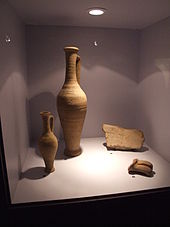Garum

Garum was a fermented fish sauce used as a condiment[1] in the cuisines of Phoenicia,[2] ancient Greece, Rome,[3] Carthage and later Byzantium. Liquamen was a similar preparation, and at times they were synonymous. Although garum enjoyed its greatest popularity in the Western Mediterranean and the Roman world, it was earlier used by the Greeks.[4][5]
Like the modern fermented soy product soy sauce, fermented garum is a rich source of umami flavoring due to the presence of glutamates.[6] It was used along with murri in medieval Byzantine and Arab cuisine to give a savory flavor to dishes.[7] Murri may well derive from garum.[8]
Pliny the Elder and Isidore of Seville derive the Latin word garum from the Greek γάρος (gáros),[9] a food named by Aristophanes, Sophocles, and Aeschylus. Garos may have been a type of fish, or a fish sauce similar to garum.[10] Pliny stated that garum was made from fish intestines, with salt, creating a liquor, the garum, and the fish paste named (h)allec or allex (similar to bagoong, this paste was a byproduct of fish sauce production).[11][10] A concentrated garum evaporated down to a thick paste with salt crystals was called muria;[12] it would have been used to salt and flavor foods.[13]
Garum was produced in various grades consumed by all social classes. After the liquid was ladled off of the top of the mixture, the remains of the fish, called allec, was used by the poorest classes to flavour their staple porridge or farinata. The finished product—the nobile garum of Martial’s epigram[14]—was apparently mild and subtle in flavor. The best garum fetched extraordinarily high prices,[15] and salt could be substituted for it in a simpler dish. Garum appears in many recipes featured in the Roman cookbook Apicius. For example, Apicius (8.6.2–3) gives a recipe for lamb stew, calling for the meat to be cooked with onion and coriander, pepper, lovage, cumin, liquamen, oil, and wine, then thickened with flour.[16] The same cookbook mentions garum being used as fish stock to flavor chopped mallow leaves fried in a skillet.[17]
